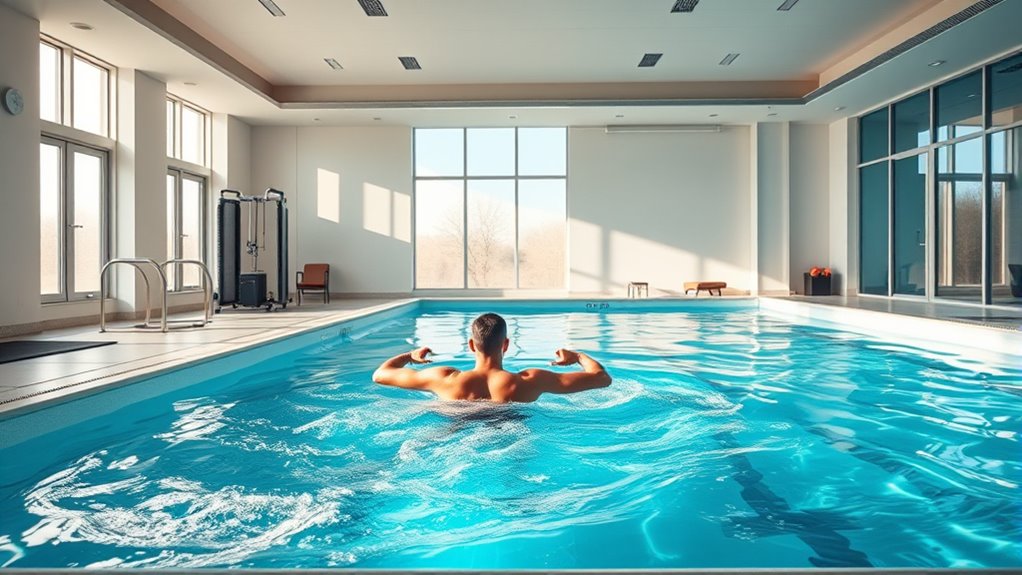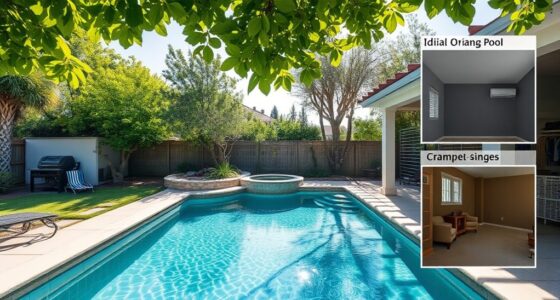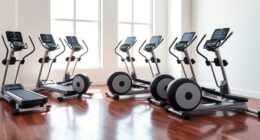To shift successfully from rehab to sport, use a structured plan with your Endless Pool that emphasizes gradual progress. Start with assessments and goal setting, then focus on gentle water mobility and stability exercises. As you build endurance, incorporate sport-specific drills and water resistance training to regain strength. Monitor your progress closely, and stay mentally prepared with confidence strategies. If you keep exploring, you’ll discover detailed protocols that can help you advance safely and effectively.
Key Takeaways
- Implement a structured, phased approach starting from assessment and gentle water exercises to advanced sport-specific skills.
- Utilize water’s buoyancy to reduce joint stress while enhancing mobility, stability, and strength safely.
- Incorporate functional drills and resistance training tailored to sport demands for effective performance restoration.
- Regularly monitor progress with objective metrics and adapt protocols to ensure safe, gradual return to activity.
- Incorporate mental resilience techniques like visualization and positive self-talk to support psychological readiness.
Assessing Readiness: Initial Evaluation and Goal Setting
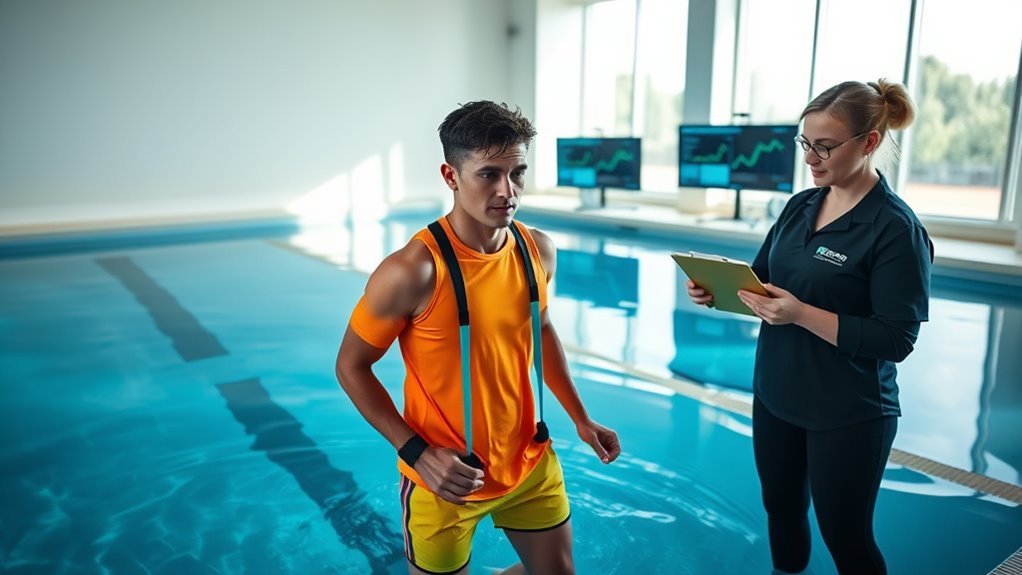
How do you determine if you’re ready to begin implementing the Endless Pool protocols? Start with an honest assessment of your current physical condition. Consult with a healthcare professional or physical therapist to evaluate your strength, flexibility, and range of motion. Set clear, achievable goals based on your injury or recovery status and sport-specific demands. Make sure your pain levels are manageable and that you’re cleared to start water-based exercises. Establish a baseline by noting any limitations or discomfort during movement. Preparing mentally is equally important—commit to the process and understand that progress may be gradual. Once your medical team approves and you feel confident in your physical readiness, you can confidently move forward with the protocols. Incorporating sound design principles into your recovery environment, such as using calming or motivating audio cues, can also support your mental focus and overall progress.
Gentle Mobility and Flexibility Exercises in the Water
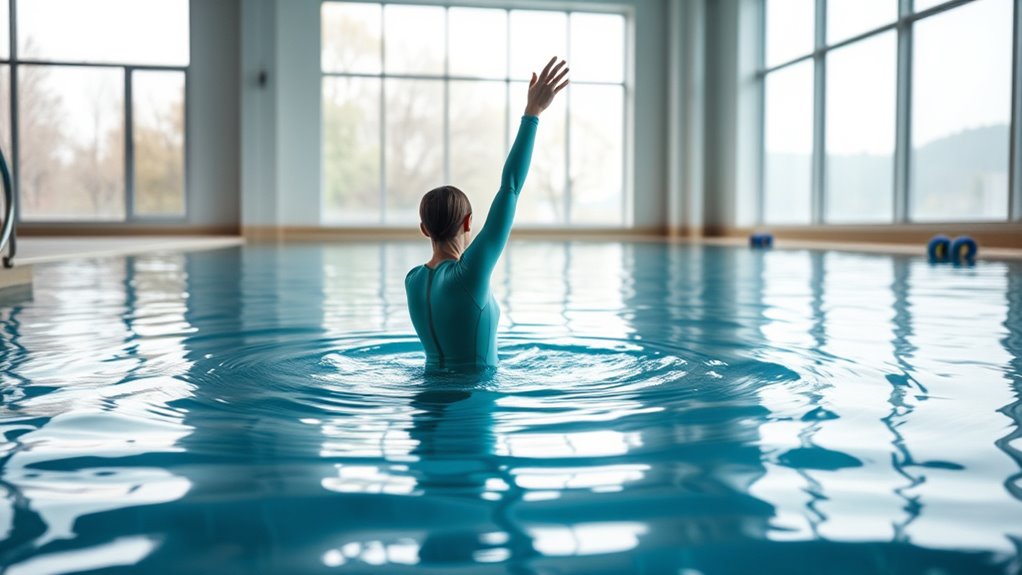
Starting your water-based routine with gentle mobility and flexibility exercises helps prepare your body for more intense activities. These exercises loosen tight muscles, improve joint range of motion, and increase circulation, reducing the risk of injury. Focus on slow, controlled movements that target key areas such as your hips, shoulders, neck, and back. Use the water’s buoyancy to support your body and ease strain on sore or recovering tissues. Incorporate gentle stretches like arm circles, leg swings, and torso twists, paying attention to your breathing. Keep movements smooth and deliberate, avoiding any pain or discomfort. This initial phase primes your muscles and joints, making subsequent exercises more effective and comfortable as you progress toward full return-to-sport activities. Utilizing appropriate recovery techniques can further enhance your progress and help maintain optimal mobility.
Building Endurance Through Low-Impact Aerobic Workouts
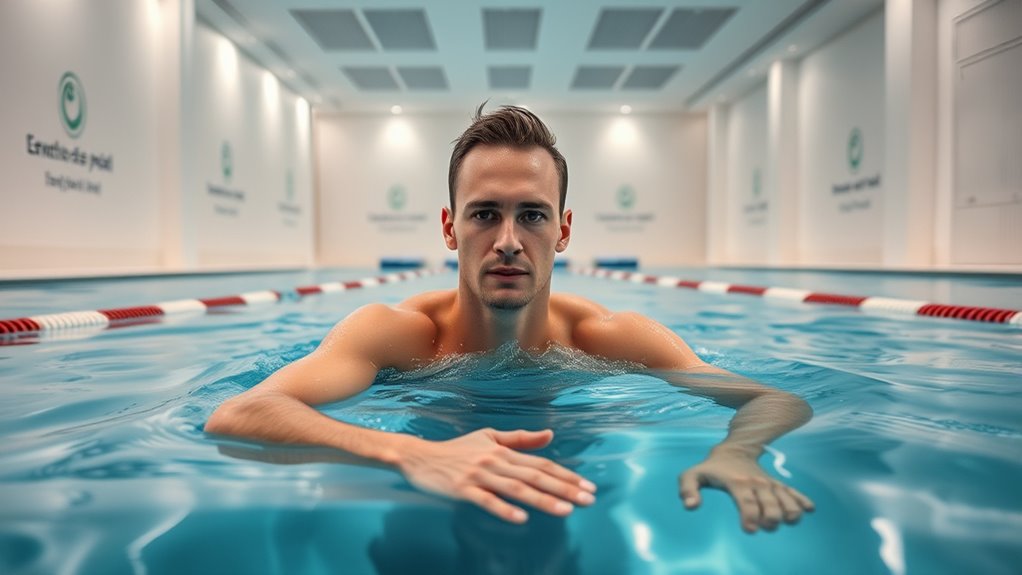
You can build endurance with low-impact aerobic workouts like gentle water running at adjustable intensities. These exercises help increase your stamina without putting stress on your joints. It’s an effective way to improve fitness while staying comfortable in the water. Incorporating mindfulness practices into your routine can further enhance your mental well-being and focus during exercise.
Gentle Water Running
Gentle water running is an effective low-impact aerobic workout that helps build endurance without stressing your joints. It allows you to maintain cardiovascular fitness while reducing the risk of injury. By mimicking land running in the water, you can improve your stamina with minimal impact. This exercise is especially helpful during rehab or when returning to sport after injury. To get the most out of water running, focus on maintaining a steady pace and proper form. Incorporate it regularly into your routine to enhance endurance gradually. Remember, consistency is key to seeing progress. Keep your movements controlled and listen to your body. This method offers a safe, effective way to stay active and build the endurance needed for a successful return to sport. Automation technologies are also playing a role in developing innovative training methods and monitoring progress remotely.
Adjustable Intensity Levels
Adjustable intensity levels in water workouts allow you to tailor exercises to your current fitness level and goals, making it easier to build endurance safely. With the Endless Pool’s adjustable settings, you can increase or decrease resistance quickly, ensuring your workout remains challenging yet manageable. This flexibility helps you progress gradually without risking overexertion or injury. For beginners, starting at lower intensities allows your body to adapt, while more advanced athletes can push harder as their stamina improves. You can fine-tune your workout in real-time, focusing on maintaining a steady pace or increasing effort for cardiovascular gains. By customizing your intensity, you stay motivated and reduce burnout, ultimately supporting a consistent, effective endurance-building routine. Additionally, understanding the importance of contrast ratio can help optimize visual feedback during your training sessions.
Minimized Joint Stress
Building endurance doesn’t mean you have to endure joint pain or discomfort. Low-impact aerobic workouts help you build stamina without stressing your joints. Using an Endless Pool allows you to stay active while minimizing impact and reducing injury risk. Water’s buoyancy supports your body, easing pressure on knees, hips, and ankles. This approach is ideal for recovery or long-term maintenance, ensuring consistent progress without setbacks. Focus on steady, controlled movements to maximize endurance and avoid strain. Incorporate these strategies to protect your joints while improving cardiovascular health:
- Maintain moderate intensity to keep stress low
- Use proper technique to prevent unnecessary strain
- Gradually increase duration for sustained improvements
- Incorporate low-impact exercises that are effective for endurance building and joint preservation
Strength Restoration Using Water Resistance Training
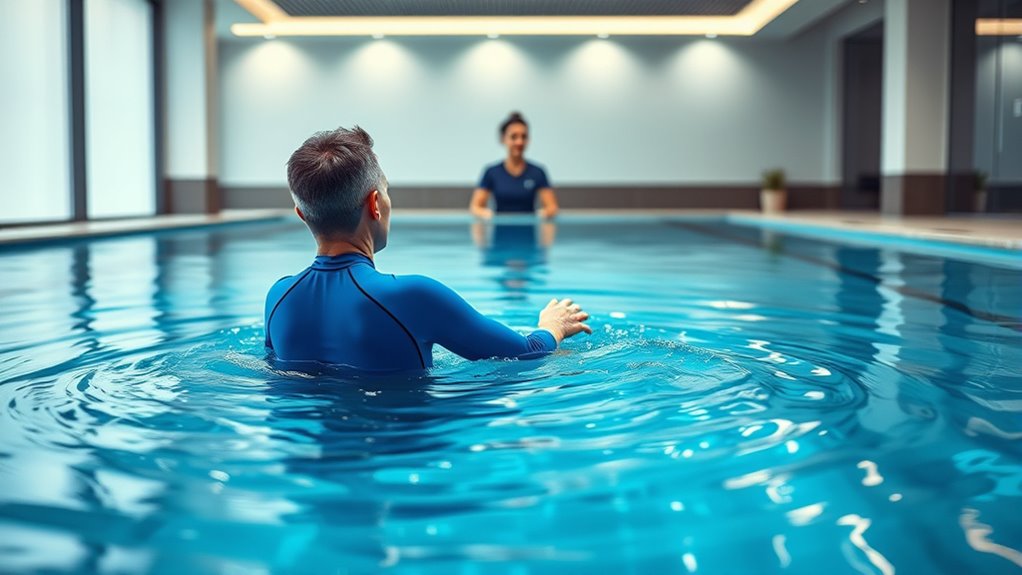
To restore strength, you can focus on gentle resistance progression that gradually challenges your muscles without overtaxing your joints. Incorporating joint stabilization techniques helps improve support and reduce injury risk during recovery. By integrating functional movements, you’ll rebuild strength more effectively and enhance your overall performance. Additionally, selecting preppy dog names that match your dog’s personality can foster a stronger bond during your training sessions.
Gentle Resistance Progression
Gentle resistance progression is a key component in restoring strength through water resistance training, especially for those recovering from injury or seeking low-impact exercise. It allows you to gradually increase load without risking re-injury or overexertion. Start with minimal resistance, focusing on controlled movements and proper form. As your strength improves, slowly add resistance to challenge your muscles without overwhelming them. This method ensures safe, consistent progress while minimizing discomfort.
Remember to listen to your body and avoid sudden increases in resistance. Consistency and patience are essential for ideal results. Recognizing the importance of vetted products can help ensure safety and effectiveness during your training. Use adjustable resistance tools to fine-tune difficulty. Focus on slow, controlled movements to maximize engagement. Gradually increase resistance as your strength stabilizes.
Joint Stabilization Techniques
As you increase resistance gradually, focusing on controlled movements helps engage stabilizing muscles around your joints. Water’s natural resistance allows you to challenge these muscles without excessive strain, promoting joint stability. Concentrate on slow, deliberate motions that keep your joints aligned and muscles activated. Use your core to maintain proper posture and prevent compensatory movements. Incorporate exercises like isometric holds, where you hold positions to build static stability, and slow, controlled range-of-motion movements to strengthen surrounding tissues. Consistent practice improves proprioception, which enhances your body’s awareness of joint position. Additionally, diverse exercise options can further enhance your rehabilitation process. Remember, the goal is to develop balanced strength and stability, reducing the risk of injury and preparing your joints for more dynamic activities. Water resistance makes this process safe and effective.
Functional Movement Integration
Integrating functional movements into water resistance training effectively restores strength by mimicking real-life activities, making workouts more applicable to everyday tasks. This approach helps you rebuild muscle patterns used daily, improving coordination and stability. By focusing on multi-joint, multi-plane movements, you enhance your body’s ability to perform activities like bending, lifting, and reaching. Water’s resistance challenges your muscles dynamically, providing a safe yet effective environment for strength gains. Incorporate exercises that simulate your specific needs to maximize recovery and functional capacity.
- Perform squats and lunges to mimic walking and stair climbing
- Use push-pull motions for shoulder and arm strength
- Include twisting and rotational movements for core stability
Advanced Skill Reintroduction and Sport-Specific Drills
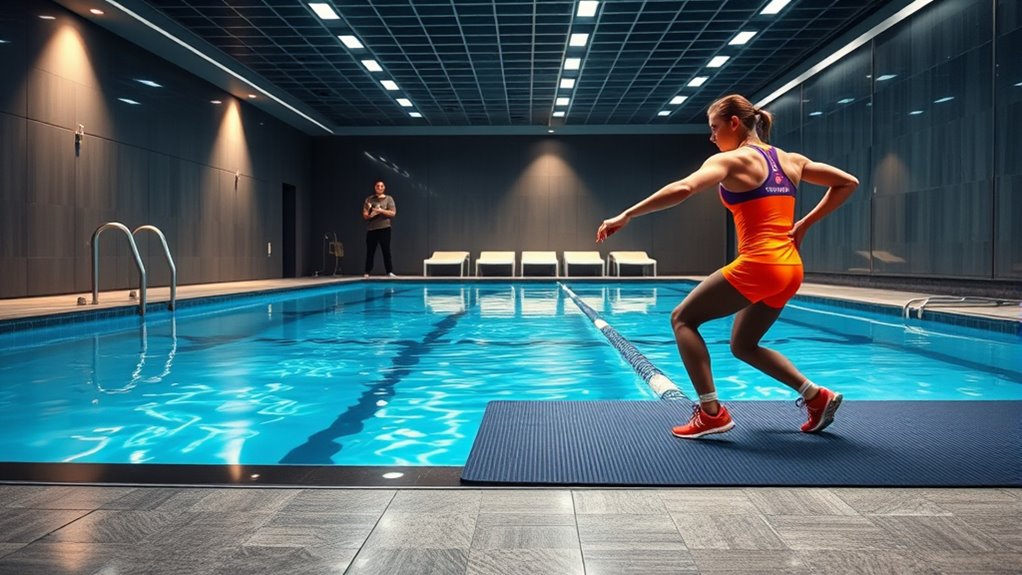
To effectively reintroduce advanced swimming skills and tailor drills to specific sports, you need to focus on targeted, sport-specific movements that challenge your current capabilities. Incorporate drills that replicate the unique demands of your sport, such as starts, turns, or explosive finishes, to build power and coordination. Use the Endless Pool’s adjustable resistance and speed settings to simulate race conditions and refine technique under realistic resistance levels. Focus on maintaining proper form while increasing intensity, ensuring movements are precise and controlled. Introduce complex drills gradually, combining multiple skills to mimic game scenarios. This approach helps you rebuild confidence, improve muscle memory, and develop sport-specific strength, ultimately preparing you to perform at your best when returning to competition.
Monitoring Progress and Adjusting Protocols Accordingly

Monitoring your progress is essential to guarantee your training remains effective and aligned with your goals. By regularly evaluating your performance, you can identify areas needing improvement and ensure you’re on track for a safe return to sport. Keep an eye on key indicators such as range of motion, strength levels, and endurance. Use objective data from your Endless Pool sessions, like timing, stroke efficiency, and recovery rates, to evaluate progress accurately. Incorporate research-backed insights to refine your protocols based on these insights to prevent plateaus or setbacks. Staying proactive allows you to modify intensity, volume, or drills as needed. Remember, consistent monitoring helps you stay motivated and ensures your training adapts to your evolving capabilities.
Psychological Preparedness and Confidence Building Strategies
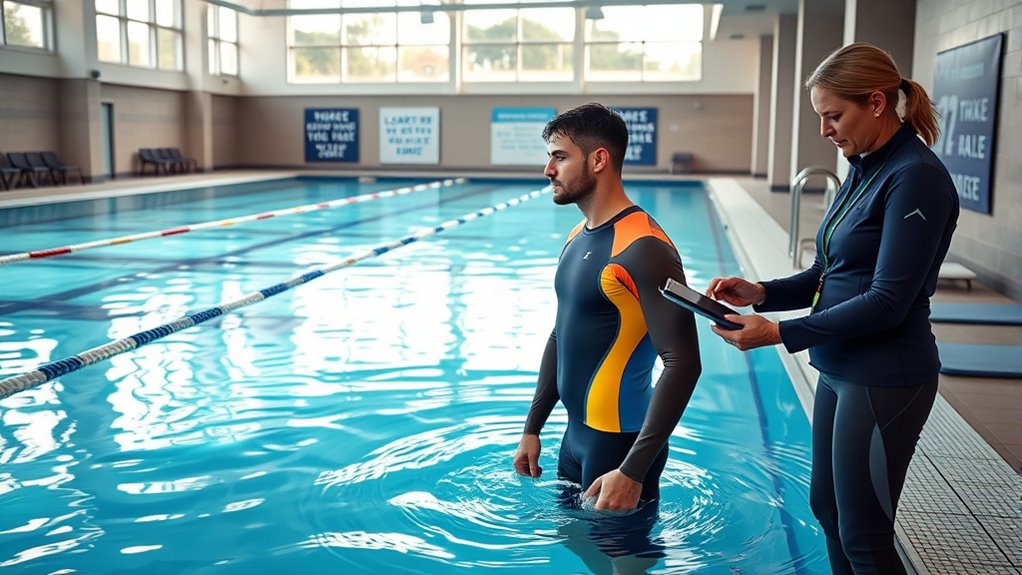
As you track your progress and make adjustments to your training protocols, developing psychological resilience becomes increasingly important. Confidence plays a key role in your return-to-sport journey; belief in your abilities fuels motivation and reduces anxiety. To build confidence, set small, achievable goals and celebrate each milestone. Visualization techniques can strengthen your mental readiness, helping you imagine successful performance. Practice positive self-talk to combat negative thoughts. Surround yourself with support from coaches, teammates, or a sports psychologist. Use the table below to identify strategies tailored to your needs:
| Strategy | Action | Benefit |
|---|---|---|
| Goal setting | Break tasks into manageable steps | Builds confidence and momentum |
| Visualization | Imagine successful performance | Reduces anxiety, improves focus |
| Positive self-talk | Replace negative thoughts with affirmations | Boosts motivation |
| Support system | Engage with coaches, teammates | Enhances resilience and trust |
Final Steps: Transitioning to Full Sport Participation
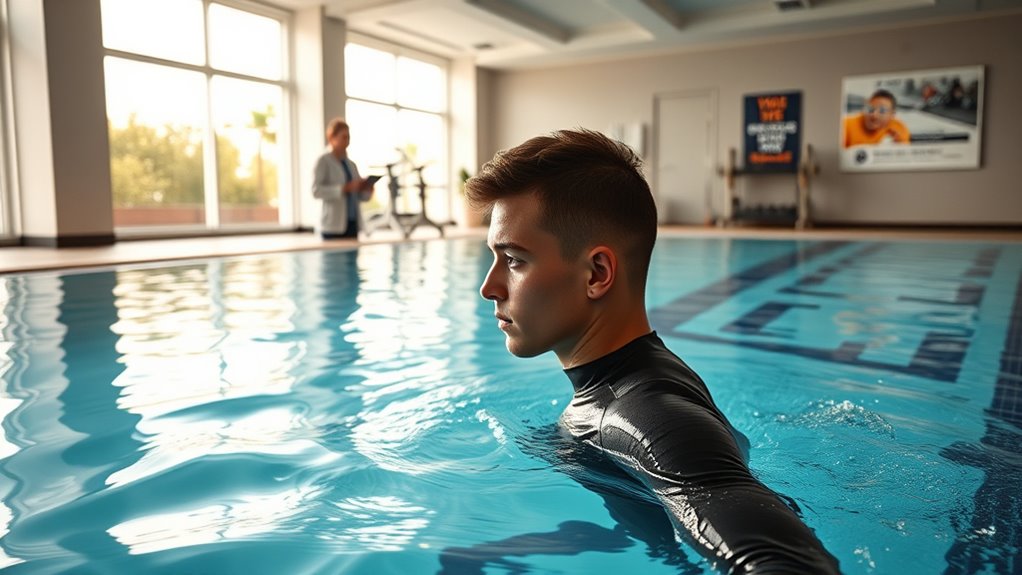
Reaching the final stage of your recovery means you’re ready to fully re-engage with your sport. This is the moment to fine-tune your skills, build confidence, and guarantee your body can handle the demands of full participation. Before jumping back in, focus on gradual exposure to sport-specific activities, monitor your body’s response, and maintain open communication with your coach or therapist. It’s essential to stay vigilant for any signs of discomfort or fatigue. Remember, this transition isn’t just physical but mental too, so trust your training and progress. To help you succeed, keep these key points in mind:
- Progressively increase intensity and duration of sport-specific drills
- Prioritize proper technique and body awareness
- Continue mental confidence practices to stay focused
Frequently Asked Questions
How Long Does Each Stage Typically Take in the Rehab Protocol?
The duration of each rehab stage varies based on your injury and progress. Generally, initial healing takes 1-3 weeks, focusing on reducing pain and swelling. The subsequent phase, restoring mobility and strength, can last 3-6 weeks. Advanced training and sport-specific drills usually extend over 4-8 weeks. Remember, listening to your body and working closely with your therapist guarantees each stage progresses safely and effectively.
Are There Specific Water Temperatures Recommended for Optimal Recovery?
You should aim for water temperatures between 88°F and 92°F for ideal recovery. Studies show that exercising in water at this range can reduce joint stress by up to 50%, speeding up healing and improving mobility. Maintaining this temperature helps decrease inflammation and pain while promoting blood flow. Always monitor water temperature closely to guarantee it remains within this ideal range, ensuring safe and effective rehabilitation.
Can These Protocols Be Adapted for Different Injury Types?
Yes, you can adapt these protocols for different injury types. You should customize water temperature, exercise intensity, and duration based on your specific injury and recovery stage. For example, use warmer water for muscle relaxation or cooler water to reduce inflammation. Consult with a healthcare professional to create a tailored plan, ensuring safe and effective rehab suited to your injury’s unique needs.
What Role Do Nutrition and Hydration Play During Aquatic Rehab?
An ounce of prevention is worth a pound of cure. Nutrition and hydration are vital during aquatic rehab because they support tissue repair, reduce inflammation, and maintain energy levels. You should prioritize balanced meals rich in protein, vitamins, and minerals, while staying well-hydrated to prevent dehydration and muscle cramps. Proper nutrition accelerates healing, ensuring you get the most benefit from your rehab sessions and return to sport stronger and healthier.
How Do You Handle Setbacks or Regressions in Progress?
When setbacks or regressions happen, you stay calm and assess the situation objectively. You identify what caused the issue—like increased pain or decreased mobility—and modify your plan accordingly. You focus on small victories to rebuild confidence and avoid frustration. Remember, setbacks are normal; use them as learning opportunities. Keep communication open with your rehab team, and stay committed to your goals, adjusting your approach as needed.
Conclusion
As you progress through these water-based protocols, remember that nearly 80% of athletes regain full confidence and return to sport within six months. Stay committed to your personalized plan, monitor your progress closely, and trust in the healing process. With patience and dedication, you’ll not only rebuild strength and confidence but also get back to doing what you love—stronger and more prepared than ever. Your journey from rehab to return is within reach.
